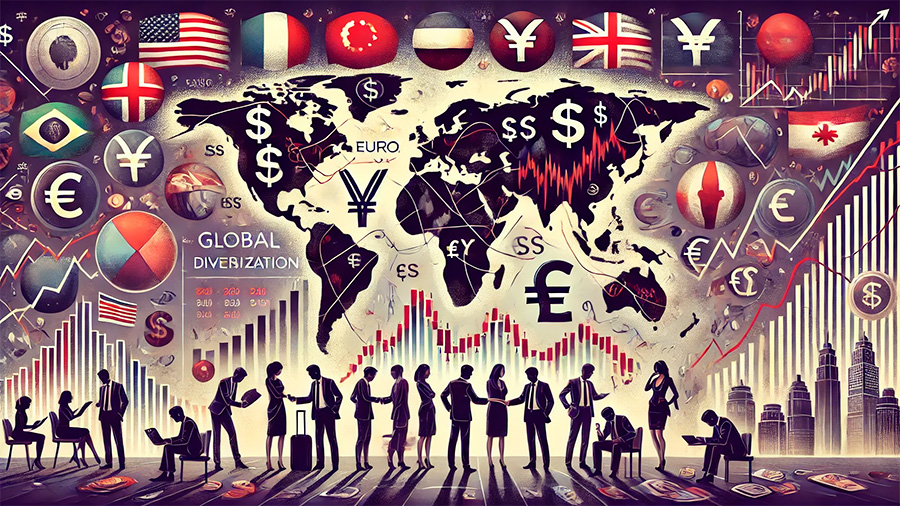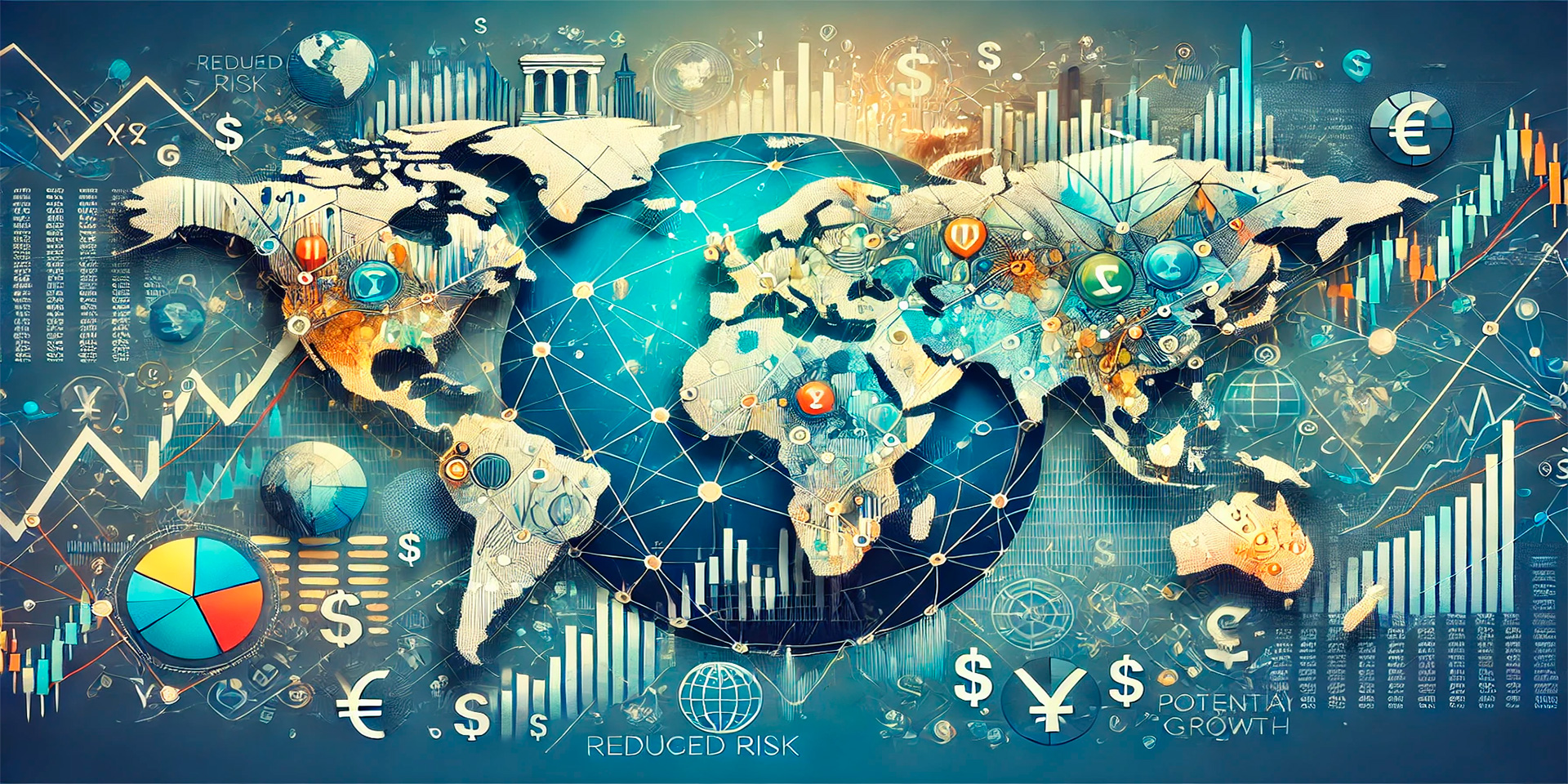Global diversification is the practice of spreading your investments across different countries and regions to reduce risk and increase potential returns. Instead of concentrating your portfolio in one country or region, you invest in a range of markets around the world. This approach helps protect your investments from local economic downturns and allows you to take advantage of growth opportunities in various global markets. In today’s interconnected world, where economies are increasingly linked, global diversification is essential for modern investors looking to build a balanced, resilient portfolio.
Why Global Diversification Matters
- Risk reduction: By investing across multiple regions, you reduce the risk of losses caused by local economic issues, such as recessions or political instability.
- Growth opportunities: Different countries experience economic growth at different rates. Global diversification allows you to tap into high-growth markets, even when your home market is underperforming.
- Currency protection: Investing globally can help hedge against currency fluctuations, which may impact the value of your home country’s currency or local investments.
Global diversification ensures that your portfolio is not overly reliant on the performance of a single country or region, offering more stability and potential for growth.
The Benefits of Global Diversification
Investing in global markets offers several key benefits that can strengthen your portfolio. These include exposure to new markets, reduced risk through diversification, and the opportunity to capitalize on international economic trends. In a world where markets are more interconnected than ever, global diversification is an essential strategy for long-term investors.

Access to Emerging Markets
One of the main advantages of global diversification is gaining access to emerging markets. These are countries with developing economies that often experience higher growth rates than more mature markets like the U.S. or Europe. Countries in regions such as Asia, Latin America, and Africa can provide significant growth opportunities as they modernize infrastructure, adopt new technologies, and expand their middle class.
- High-growth potential: Emerging markets tend to grow faster than developed economies, providing the opportunity for higher returns.
- Diversification from developed markets: Because emerging markets operate differently from developed economies, their growth cycles may not coincide, offering a counterbalance to slower-growing markets.
By including emerging market investments in your portfolio, you can benefit from global economic trends and potentially boost your returns.
Reducing Country-Specific Risk
Every country’s economy is subject to unique risks, including political instability, natural disasters, regulatory changes, or sector-specific downturns. If your portfolio is concentrated in one country, it is more vulnerable to these risks. Global diversification spreads your investments across different regions, reducing the impact of any single event or crisis on your overall portfolio.
- Political and economic stability: By diversifying across stable and emerging markets, you protect your investments from unexpected shocks in any single region.
- Sector exposure: Different countries specialize in different industries, and global diversification allows you to gain exposure to a wide range of sectors, including technology, healthcare, energy, and agriculture.
A globally diversified portfolio helps shield your investments from localized risks while offering broader opportunities for growth.
How to Implement Global Diversification
Achieving global diversification in your portfolio requires strategic planning and a clear understanding of international markets. There are several ways to invest globally, including direct investment in foreign stocks, exchange-traded funds (ETFs), and mutual funds. The key is to spread your investments across different regions, sectors, and asset classes to build a balanced portfolio.
Investing in International Stocks
One way to achieve global diversification is by directly purchasing stocks in foreign companies. This gives you direct exposure to the growth and profitability of businesses in various countries. Many global giants, such as Nestlé, Samsung, and Alibaba, operate across multiple markets and can provide a significant boost to your portfolio.
- Diversification by country: Buying individual stocks from different countries ensures that you are not overly exposed to the risks of any one country’s economy.
- Sector diversification: Many foreign companies dominate specific sectors (e.g., technology in China, pharmaceuticals in Switzerland), providing a broader range of opportunities.
While investing in foreign stocks directly can be rewarding, it requires significant research to understand the economic and political dynamics of each country.
Global Exchange-Traded Funds (ETFs) and Mutual Funds
For investors who want exposure to international markets without the complexity of buying individual stocks, global ETFs and mutual funds offer a simple and cost-effective solution. These funds pool investments in a basket of international stocks or bonds, allowing you to diversify your portfolio across multiple regions with a single investment.
- Global equity funds: These funds invest in companies from various countries, spreading risk and providing exposure to international markets.
- Emerging market funds: For those specifically interested in high-growth regions, emerging market funds focus on countries with rapidly growing economies, such as China, Brazil, and India.
- Bond funds: Global bond funds provide exposure to international debt markets, offering a more conservative option for income-seeking investors.
Global ETFs and mutual funds allow investors to gain access to a wide range of markets, sectors, and industries, making it easier to build a well-diversified portfolio.

Understanding the Risks of Global Investing
While global diversification offers many benefits, it also comes with risks that investors need to consider. Currency fluctuations, political instability, and varying economic conditions can impact the performance of your international investments. Understanding these risks is crucial to building a successful globally diversified portfolio.
Currency Risk
One of the main risks of investing internationally is currency risk. Changes in exchange rates can affect the value of your investments when converted back to your home currency. For example, if the currency of the country you are investing in weakens against your home currency, the returns on your investment may be reduced, even if the asset itself has gained in value.
- Hedging against currency risk: Some international funds use currency hedging strategies to protect investors from adverse exchange rate movements.
- Monitoring currency trends: Understanding global currency trends can help you mitigate risks associated with fluctuations in exchange rates.
While currency risk can affect the value of your international investments, it’s important to remember that these fluctuations often balance out over the long term.
Political and Economic Risks
Investing globally exposes your portfolio to different political and economic environments. Countries with unstable governments or weak regulatory systems may present higher risks for investors, such as sudden policy changes, nationalization of industries, or high inflation rates. Additionally, economic cycles vary by region, and certain countries may experience recessions while others are thriving.
- Diversifying across regions: By spreading your investments across developed and emerging markets, you reduce your exposure to country-specific political and economic risks.
- Monitoring global developments: Keeping up with global political and economic news can help you stay informed about potential risks and opportunities.
Although political and economic risks are inherent in global investing, a well-diversified portfolio can minimize the impact of these challenges.
Balancing Global and Domestic Investments
While global diversification is essential, it’s equally important to maintain a balance between international and domestic investments. A portfolio that is too heavily weighted in foreign assets may become overexposed to risks such as currency fluctuations and political instability. Striking the right balance ensures that your portfolio benefits from global growth while remaining anchored in more familiar domestic markets.
How to Balance Global and Domestic Investments
- Home-country bias: Many investors tend to allocate more of their portfolio to their home country’s assets. While this can provide comfort, it may limit growth opportunities and leave the portfolio exposed to domestic risks.
- Diversifying by asset class: Ensure that your global and domestic investments are spread across different asset classes, such as equities, bonds, and real estate.
- Monitoring performance: Regularly review your portfolio to ensure that it remains balanced and aligned with your risk tolerance and investment goals.
Balancing global and domestic investments helps create a portfolio that is diversified, resilient, and well-positioned for long-term success.
Global Diversification: A Key Strategy for Modern Investors
In today’s interconnected world, global diversification is more important than ever. Spreading your investments across different regions allows you to reduce risk, tap into new growth opportunities, and protect your portfolio from local economic downturns. By investing in international stocks, ETFs, and mutual funds, you can build a globally diversified portfolio that is positioned for long-term success.
However, it’s crucial to remain mindful of the risks associated with global investing, such as currency fluctuations and political instability. By balancing your global and domestic investments, diversifying across asset classes, and regularly reviewing your portfolio, you can make the most of global diversification in modern investing.
Global diversification offers investors a powerful tool for managing risk and capturing growth opportunities in markets around the world. Whether you’re a conservative investor or have a higher risk tolerance, incorporating global assets into your portfolio is key to navigating today’s complex and dynamic investment landscape.

